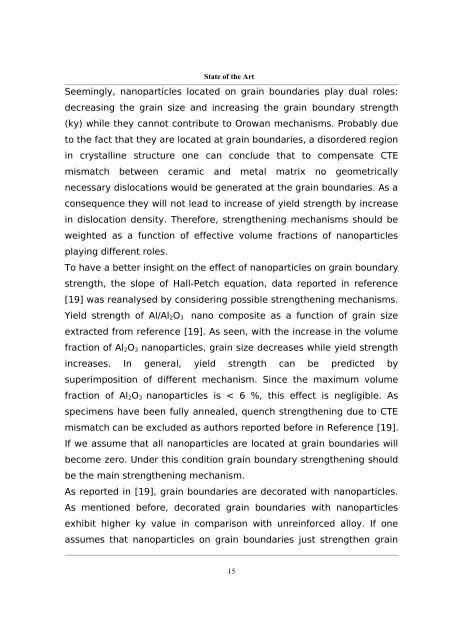Cláudia Sofia de Andrade Redondo Murilhas Buchheim ...
Cláudia Sofia de Andrade Redondo Murilhas Buchheim ...
Cláudia Sofia de Andrade Redondo Murilhas Buchheim ...
Create successful ePaper yourself
Turn your PDF publications into a flip-book with our unique Google optimized e-Paper software.
State of the Art<br />
Seemingly, nanoparticles located on grain boundaries play dual roles:<br />
<strong>de</strong>creasing the grain size and increasing the grain boundary strength<br />
(ky) while they cannot contribute to Orowan mechanisms. Probably due<br />
to the fact that they are located at grain boundaries, a disor<strong>de</strong>red region<br />
in crystalline structure one can conclu<strong>de</strong> that to compensate CTE<br />
mismatch between ceramic and metal matrix no geometrically<br />
necessary dislocations would be generated at the grain boundaries. As a<br />
consequence they will not lead to increase of yield strength by increase<br />
in dislocation <strong>de</strong>nsity. Therefore, strengthening mechanisms should be<br />
weighted as a function of effective volume fractions of nanoparticles<br />
playing different roles.<br />
To have a better insight on the effect of nanoparticles on grain boundary<br />
strength, the slope of Hall-Petch equation, data reported in reference<br />
[19] was reanalysed by consi<strong>de</strong>ring possible strengthening mechanisms.<br />
Yield strength of Al/Al 2 O 3 nano composite as a function of grain size<br />
extracted from reference [19]. As seen, with the increase in the volume<br />
fraction of Al 2 O 3 nanoparticles, grain size <strong>de</strong>creases while yield strength<br />
increases. In general, yield strength can be predicted by<br />
superimposition of different mechanism. Since the maximum volume<br />
fraction of Al 2 O 3 nanoparticles is < 6 %, this effect is negligible. As<br />
specimens have been fully annealed, quench strengthening due to CTE<br />
mismatch can be exclu<strong>de</strong>d as authors reported before in Reference [19].<br />
If we assume that all nanoparticles are located at grain boundaries will<br />
become zero. Un<strong>de</strong>r this condition grain boundary strengthening should<br />
be the main strengthening mechanism.<br />
As reported in [19], grain boundaries are <strong>de</strong>corated with nanoparticles.<br />
As mentioned before, <strong>de</strong>corated grain boundaries with nanoparticles<br />
exhibit higher ky value in comparison with unreinforced alloy. If one<br />
assumes that nanoparticles on grain boundaries just strengthen grain<br />
15
















